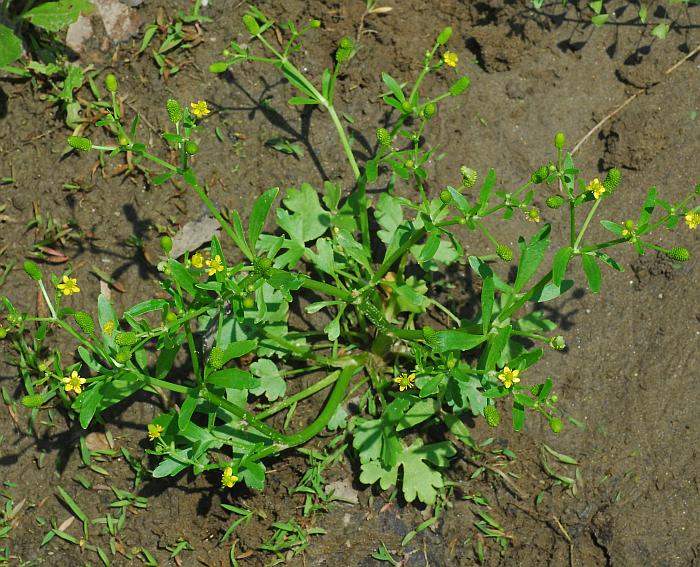Ranunculus sceleratus L.
Cursed Crowfoot

Native
CC = 5
CW = -5
MOC = 31
© SRTurner
Ranunculus sceleratus L.Cursed Crowfoot | |
 |
Native CC = 5 CW = -5 MOC = 31 |
© SRTurner |
|
Family - Ranunculaceae Habit - Annual forb with usually exensive, fibrous, somewhat fleshy roots. Terrestrial or emergent aquatic. Stems - Ascending to erect, to 60 cm, stout but hollow and easily broken, glabrous, branching, the base not bulbous.
Leaves - Basal and alternate. Basal leaves present at flowering, long-petiolate, the blade 1-7 cm long, 3-9 cm wide, kidney-shaped to more or less semicircular, deeply 3-lobed, the base broadly cordate or less commonly truncate, the lobes obovate to bluntly rhombic, at least the central lobe usually again 3-lobed, rounded or bluntly pointed at the tip, the margins otherwise scalloped. Stem leaves mostly short-petiolate to sessile, deeply 3-lobed or-parted nearly to the base, the lobes linear to oblanceolate or narrowly rhombic-elliptic, the margins entire or nearly so or those of the lower leaves shallowly lobed or bluntly toothed or scalloped.
Inflorescence - Flowers on short or long peduncles terminating branches, often appearing axillary. Peduncles glabrous or with few sparse hairs, subtended by leafy bracts.
Flowers - Sepals 3-5, 2-4 mm long, reflexed from at or just above the base (lacking a transverse fold), more or less plane. Petals usually 5, free, 2-5 mm long, 1-3 mm wide, obovate, as long as or slightly longer than the sepals, glossy yellow. Style absent. Stamens about 20, from base of pistils. Filaments to 2 mm long, glabrous, pale yellow. Anthers yellow, 0.3 mm long. Pistils in a cylindric head expanding in fruit.
Fruits - Head of achenes 3-12 mm long at maturity, at first globose to ovoid but usually becoming cylindric, the receptacle sparsely hairy or glabrous. Achenes 0.8-1.2 mm long, flattened, the margins corky-thickened, unwinged, the wall thick, with a network of very fine cross-wrinkles, glabrous, the beak essentially absent (reduced to a minute, off-center, peglike structure).
Flowering - April - August. Habitat - Streambanks, pond margins, sloughs, swamps, marshes, crop fields, pastures, ditches, muddy disturbed areas. Origin - Native to the U.S. Lookalikes - R. abortivus, R. flabellaris. Other info. - This plant is found in scattered locations in Missouri, most common by far in counties bordering the large rivers. It is likewise widely scattered across the eastern half of the U.S., and in west coast states where it is apparently introduced. Identification is straightforward, with the plant having all basal leaf blades lobed, fleshy stems, and small buttercup-pattern flowers. The petals are glossy, as is the case with most buttercups. The petals are also rounded at the apex, which serves as a quick means of distinguishing this species from R. abortivus (check the basal leaves for confirmation). The plant is often found in fallow crop fields located in large river floodplains. Photographs taken in Parkville City Park, Parkville, MO., 6-10-00 (DETenaglia); also at Klondike County Park, St. Charles County, MO, 5-15-2014, near Labadie, Franklin County, MO, 5-17-2019, Pacific Palisades Conservation Area, MO, 5-18-2019, and the Katy Trail near Dutzow, Warren County, MO, 4-3-2020 (SRTurner). |